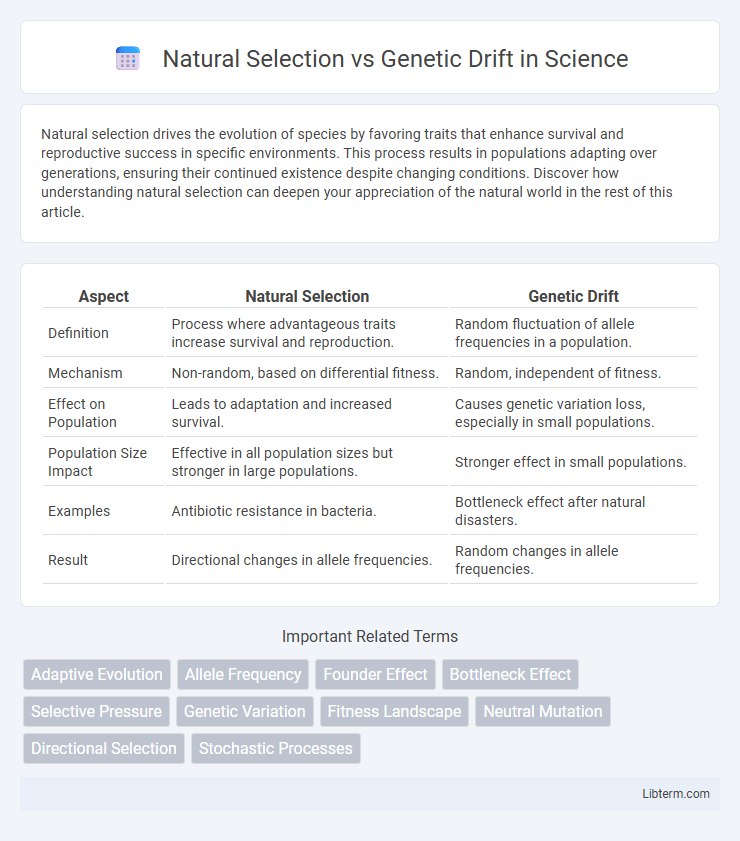Natural selection drives the evolution of species by favoring traits that enhance survival and reproductive success in specific environments. This process results in populations adapting over generations, ensuring their continued existence despite changing conditions. Discover how understanding natural selection can deepen your appreciation of the natural world in the rest of this article.
Table of Comparison
| Aspect | Natural Selection | Genetic Drift |
|---|---|---|
| Definition | Process where advantageous traits increase survival and reproduction. | Random fluctuation of allele frequencies in a population. |
| Mechanism | Non-random, based on differential fitness. | Random, independent of fitness. |
| Effect on Population | Leads to adaptation and increased survival. | Causes genetic variation loss, especially in small populations. |
| Population Size Impact | Effective in all population sizes but stronger in large populations. | Stronger effect in small populations. |
| Examples | Antibiotic resistance in bacteria. | Bottleneck effect after natural disasters. |
| Result | Directional changes in allele frequencies. | Random changes in allele frequencies. |
Introduction to Natural Selection and Genetic Drift
Natural selection is a process where organisms with advantageous traits have higher survival and reproductive success, leading to the gradual adaptation of populations over generations. Genetic drift involves random changes in allele frequencies within a population, often having a more significant impact in small populations, causing genetic variation to fluctuate unpredictably. Both mechanisms drive evolution, but natural selection is deterministic based on fitness, while genetic drift is stochastic and not directly related to organismal advantage.
Defining Natural Selection
Natural selection is a mechanism of evolution where organisms with favorable traits have higher survival and reproductive success, leading to the gradual adaptation of populations. It operates through differential reproductive success based on inherited characteristics that enhance fitness in a specific environment. Unlike genetic drift, which involves random changes in allele frequencies, natural selection is a non-random process driven by environmental pressures.
Understanding Genetic Drift
Genetic drift refers to random fluctuations in allele frequencies within a population, which can lead to significant genetic variation over time, especially in small populations. Unlike natural selection, which favors traits that enhance survival and reproduction, genetic drift operates without regard to fitness, causing alleles to increase or decrease in frequency purely by chance. This process can result in the loss of genetic diversity and the fixation of neutral or even deleterious alleles within isolated populations.
Key Differences Between Natural Selection and Genetic Drift
Natural selection drives changes in allele frequencies based on differential reproductive success, favoring traits that enhance survival and adaptation to the environment. Genetic drift causes random fluctuations in allele frequencies due to chance events, significantly impacting small populations regardless of trait advantage. Unlike natural selection, genetic drift does not necessarily produce adaptive changes and can lead to the loss of genetic variation over time.
Mechanisms Driving Natural Selection
Natural selection operates through mechanisms such as variation in traits, differential survival, and reproduction advantages that increase the frequency of beneficial alleles in a population. Environmental pressures favor individuals with advantageous phenotypes, leading to adaptive evolution over generations. Unlike genetic drift, which involves random fluctuations in allele frequencies, natural selection consistently drives populations toward greater fitness.
Mechanisms Driving Genetic Drift
Genetic drift occurs through random fluctuations in allele frequencies within a population, primarily driven by stochastic events such as population bottlenecks and founder effects. These mechanisms reduce genetic variation by chance rather than adaptive advantage, causing some alleles to become fixed or lost over generations. Unlike natural selection, genetic drift operates independently of an organism's fitness and is particularly influential in small populations.
Impacts on Genetic Variation
Natural selection systematically increases the frequency of beneficial alleles, promoting adaptive genetic variation within populations, while reducing harmful variants. Genetic drift causes random fluctuations in allele frequencies, often decreasing genetic variation, especially in small populations, and can lead to the fixation or loss of alleles regardless of their adaptive value. Both processes shape genetic diversity, but natural selection is directional and adaptive, whereas genetic drift is stochastic and non-adaptive.
Examples in Nature: Natural Selection vs Genetic Drift
Natural selection drives adaptive changes in populations, such as the peppered moth's coloration shift during the Industrial Revolution, where darker moths had higher survival rates. Genetic drift causes random fluctuations in allele frequencies, evident in the isolated Amish population exhibiting a higher prevalence of certain genetic disorders. These mechanisms highlight how natural selection results in advantageous traits becoming common, while genetic drift can alter populations regardless of fitness effects.
Role in Evolutionary Processes
Natural selection drives evolution by favoring alleles that increase an organism's fitness, leading to adaptive traits becoming more common in populations. Genetic drift causes random fluctuations in allele frequencies, especially in small populations, potentially leading to the loss or fixation of alleles regardless of their adaptive value. Both mechanisms shape genetic diversity, but natural selection actively molds traits for survival, while genetic drift introduces stochastic changes influencing evolutionary trajectories.
Conclusion: Comparing Evolutionary Forces
Natural selection drives adaptive evolution by favoring alleles that increase organismal fitness within specific environments, leading to non-random changes in allele frequencies. In contrast, genetic drift causes random fluctuations in allele frequencies, especially significant in small populations, potentially leading to neutral or even deleterious traits becoming fixed. Comparing these forces highlights that natural selection is directional and adaptive, while genetic drift is stochastic and can reduce genetic variation, both playing critical roles in shaping evolutionary trajectories.
Natural Selection Infographic

 libterm.com
libterm.com